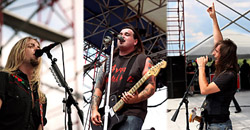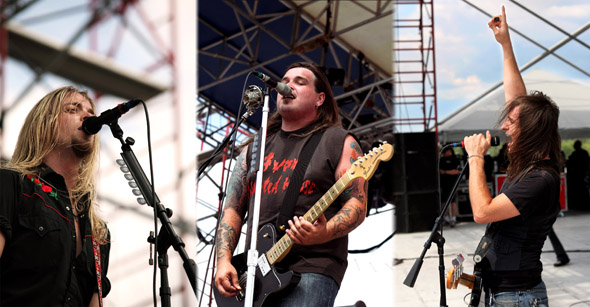Based in Edmonton, Kentucky, Black Stone Cherry began using beyerdynamic microphones a few years back, after visiting the company’s booth at the winter NAMM show.
“We tried a few beyerdynamic mics out on the road and they just sounded so much better – especially the vocal mics,” the band’s bassist Jon Lawhon recalls.
“All of a sudden, people started complimenting us on the backing vocals, and the only change we had made was the mics.”
Until then, nobody ever said anything about our vocals. We knew we hadn’t changed, so it had to be the mics.”
Lead vocalist Chris Robertson uses the Beyer TG-X 930-NI, a cardioid condenser with a nickel finish.
“The reason we use the condenser on Chris is because his voice is kind of unique, very gravelly, and sometimes it’s hard to get it on top of the mix, especially on some of our heavier songs.”
“But that TG-X 930 is so responsive, all his lower-register vocals really started coming out. And the mic has a nice, tight pattern, so we also lost a lot of the cymbal bleed that we had been fighting. It’s the perfect mic for him.” In the studio, Robertson uses both the TX-G 930 and the Beyer M99, a large-diaphragm dynamic mic, depending on the material.
One of the workhorse mics for the band, both on stage and in the studio, is the M201, an end-firing dynamic mic used on John Fred Young’s snare and Ben Wells’ guitar rig.
“It’s like a classic dynamic mic with a wider range of response. When we put that on John Fred’s snare, suddenly you could actually hear all the ghost notes he plays between the beats, even when it’s gated,” reports Lawhon. “It really lets the crowd feel the groove he’s laying down.”
For his own bass rig, Jon Lawhon uses a very straightforward setup in live performance, miked with an Opus 99 dynamic in combination with a DI box. It’s a different story in the studio.
“I actually play three rigs when we’re recording, each of them completely different. It’s two bass rigs and one guitar amp. I set them up to get completely different sounds off each amp, then blend them together when we mix.”
To handle the signal flow, Lawhon uses a powered, impedance-matching splitter devised by the band’s monitor engineer and B.A.M.F. owner Ryan Gorman (a.k.a. Jonesy), who along with Lawhon is a graduate of The Recording Workshop in Chillicothe, Ohio.
Lawhon’s studio set-up includes an M99 large diaphragm dynamic on his Peavey VB3 8×10 stack for a classic rock bass tone. For the modern side of things he uses a Peavey Tour 700 head with a Tour 8-10 cabinet, miked with a Beyer M88.
His guitar rig is a 1967 Fender Bassman, paired with a 4-10 Marshall cabinet and miked with Beyer’s MC930 condenser. “I do it all in one shot, running through a powered impedance-matching splitter that Jonesy, our monitor engineer, put together for me,” he explains.
“This setup gives me everything I need: pure subsonic lows, punchy, straight-ahead rock and roll bass, plus a bright, biting tone with great attack. “It’s the same setup I used on the last record, but this is the first time I’ve recorded it with Beyer mics. After we finished the first demos, I was like, ‘wow, that’s substantially better.’”
In recording their own demos, the band has decided to expand its use of Beyer microphones.”
“Where drummer John Fred Young uses Opus 88 clip-on mics for his toms on stage, he uses the Beyer M88 dynamic in the studio. Guitarist Ben Wells’ Peavey amps benefit from use of the M160 dual-ribbon mic paired with the same M201 used on tour.
When informed that the M160 is famed for its use on classic Jimi Hendrix and Led Zeppelin recordings of the late 60s, Lawhon was amazed. “Really? I had no idea. We just picked it because it gave us a great tone. But that’s very cool, because Zeppelin, as well as Hendrix, is a big part of our influence.”
“I guess you could call it hard rock with a southern flair,” he says, “but we really try to just make it our own. As a band, we will try anything and everything until we’ve found the best thing.”
“That’s true for our music and for our equipment. It just so happens that, across the board, live and in the studio, based on the sound, we prefer the Beyer mics.”





















